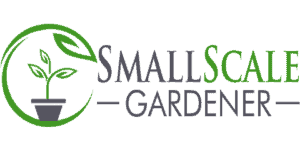Growing meat and vegetables in a symbiotic relationship, like aquaponics, helps each method be more efficient and environmentally friendly. The more I learned about raising fish and growing plants without soil, like in aeroponics or hydroponics, the more I wanted to learn about aquaponics.
Aquaponics is the combination of aquaculture (growing fish in a controlled environment or tank) with hydroponics (growing plants without soil). In an aquaponics system, waste from the fish fertilizes the plants, and the plants filter and clean the water for the fish.
Aquaponics is a highly efficient technique to cultivate both fish and plants. In this article, I’ll guide you through everything you need to know about aquaponics including what it is, how it works, the parts of a system, some different systems you could build, and the benefits of growing with aquaponics.
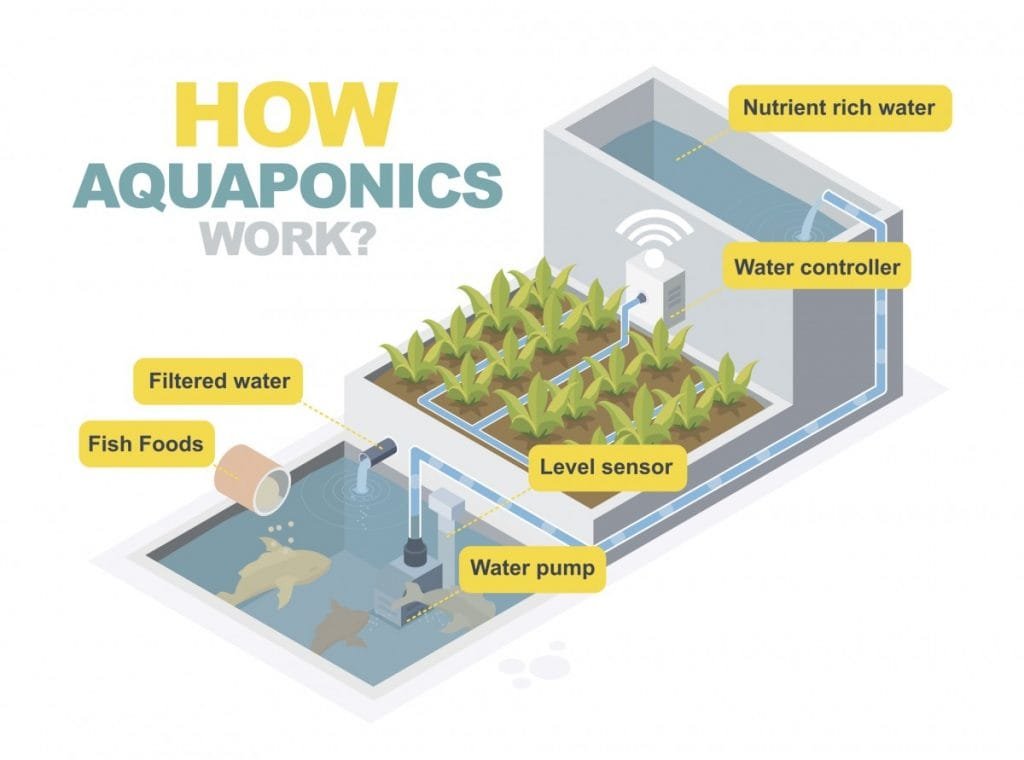
What is Aquaponics
Aquaponics combines aquaculture and hydroponics to form a highly-efficient and sustainable hybrid fish and plant production system. It combines the strengths of both aquaculture and hydroponics, and in doing so, their individual drawbacks are eliminated.
Aquaculture is the farming of fish and other water based creatures. Hydroponics is the practice of growing plants in water, without soil. Learn more about hydroponics in my article, What is Hydroponics – The Complete Guide.
Beyond Traditional Aquaculture
Traditional aquaculture produces large quantities of ammonia-rich wastewater, which can be harmful to the environment and is difficult to dispose of. Ammonia is produced when raising fish, as fish create it in their metabolic systems and excrete it in their waste.
To keep the fish healthy, ammonia must be removed from the aquaculture system. High quantities of ammonia impair fish growth, damages fish tissues, decrease the fish’s immune response, and can even kill the fish.
Think of a fish tank. To keep the tank clean, you need to filter and circulate the water. If you don’t, the fish will get sick and eventually die. The offputting smell of a dirty fish tank is usually from ammonia and chemicals like it.
In many regions, it is illegal or expensive to dump large volumes of ammonia-rich wastewater down the drain, since it is environmentally harmful. Aquaponics provides a sustainable solution by pumping the ammonia-rich wastewater out of the fish tank to be repurposed and recycled by growing plants.
Repurposing Ammonia in Aquaponics
Ammonia is a nitrogen-containing chemical. Fortunately, nitrogen-containing chemicals are just what plants need to grow.
Simple chemical reactions can convert the ammonia in the fish wastewater into nitrate, an extremely effective plant fertilizer. In the process, the ammonia is removed from the water, cleaning it.
The chemical reactions to repurpose the nitrogen are mediated by bacteria in the system through a process called biofiltration. I’ll come back to that later, as it plays a vital role to consider when building your own aquaponics systems.
The cleaned water can then be circulated back into the aquaculture tank, and the fish will continue to healthily grow.
Efficiency in Aquaponics Systems
Aquaponics systems are highly-efficient and sustainable because:
- They eliminate the need to dispose of the large quantities of ammonia-rich wastewater produced by aquaculture. This saves a lot of money, as disposal and treatment are expensive.
- Plants are given a steady stream of nitrate fertilizer for their growth. No fertilizer needs to be purchased or added to the system, since it all comes from the fish waste.
- The fertilizer is highly nutrient-rich. Plants in aquaponics systems are known to grow faster than their agricultural relatives because the fertilizer produced is of such high quality. Occasionally, iron or potassium supplements may be added.
- It’s easy. All you need to do in an aquaponics system is set it up, feed the fish, plant the seeds, and occasionally add some water.
- They don’t use much water. Plants grown in aquaponics systems need an estimated 2% of the amount of water needed to grow them by traditionally irrigated agriculture.
- They use very small amounts of land. You can fit your own hydroponics system in your backyard and start growing plants today.
Let’s take a closer look at aquaponics systems and how they work, and then how you can build one in your own backyard.
How Aquaponics Works
For plants to grow, they need a steady stream of nitrate. In traditional agriculture, this is provided by fertilizer. The most effective fertilizers are animal wastes, such as cow manure, since these contain huge amounts of nitrate, nitrogen-containing chemicals, and other nutrients and minerals.
In a traditional hydroponic system, nitrate and other minerals must be added to the water using a nutrient solution. Learn more about these nutrient solutions in our article, Hydroponic Nutrient Solutions – Complete Guide.
Aquaponics works by leveraging and maintaining a consistent Nitrogen Cycle. It recycles nitrogen-rich wastes from aquaculture to supply nutrients to plants. In the process, toxic nitrogen-containing compounds are removed from the water, and the aquaculture tank remains suitable for the fish.
Once nitrogen is regularly circulating from fish to bacteria to plants, the only inputs needed for the system are water, oxygen, light, fish feed, and electricity. Once running, the only effort an aquaponics system requires is a water top-off every week and daily food for the fish.
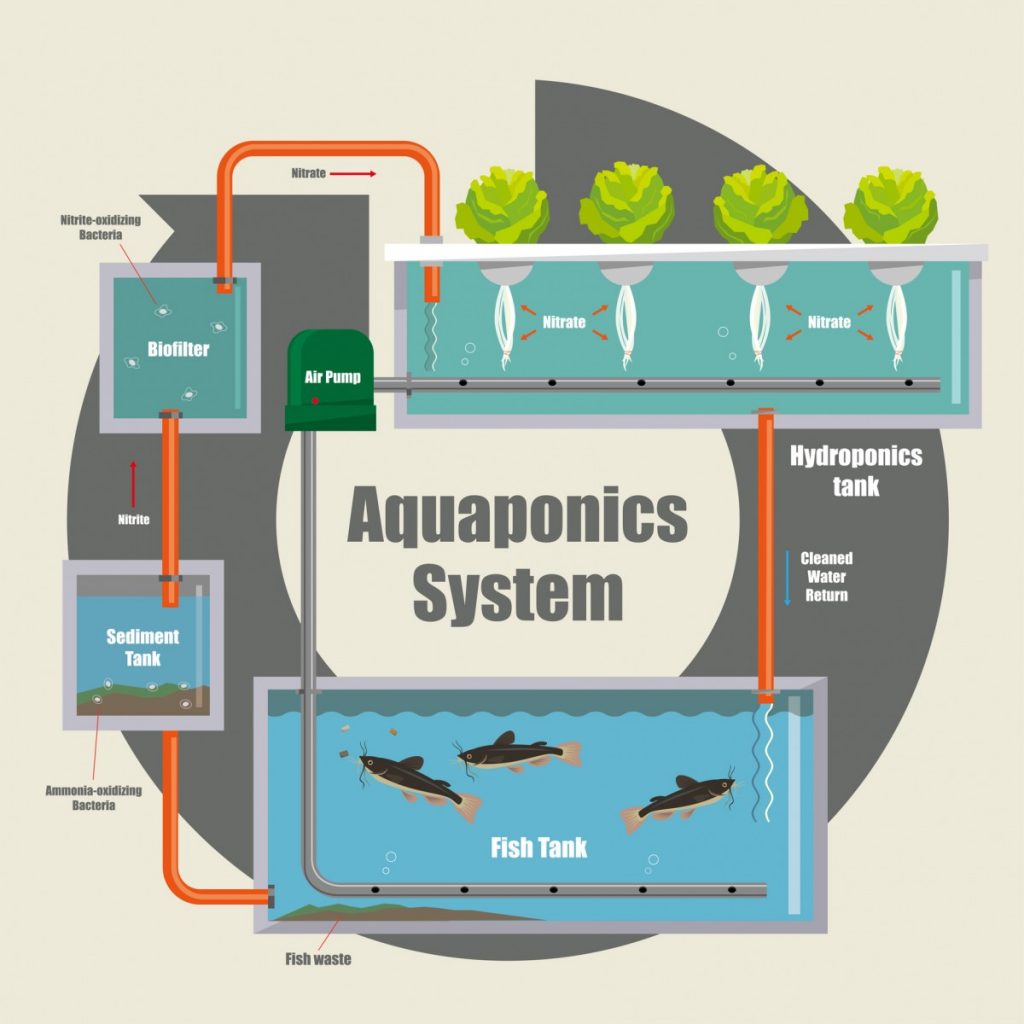
Dirty Water Becomes Plant Fertilizer In Aquaponics
Fish wastes usually do not contain much nitrate, but they do contain large quantities of ammonia, another nitrogen-containing chemical. The ammonia must be removed from the water for the fish to keep growing; otherwise, they get sick and die.
Much like the cleaning pump in a home fish tank, a pump removes the wastewater from the aquaculture tank. While in a home fish tank, the water is passed through a series of filters, in aquaponics, the wastewater is passed through filters to remove solids into the plant bed. The dirty water is removed from the tank in the process.
In the plant bed, one strain of naturally-occurring bacteria, called Nitrosomonas, oxidizes the ammonia from the wastewater, turning it into nitrite. Nitrite still cannot be used to fertilize the plants and is toxic to fish. The second strain of bacteria, called Nitrobacter, oxidizes the nitrite further, producing nitrate for plant usage.
The plants thus have a steady stream of nitrate and water, and they grow quickly. In the process, the ammonia has been removed from the wastewater. After passing through the plant bed, the cleaned water is circulated back into the fish tank.
This method is similar to rhizofiltration – using plant roots to filter and clean water – however, it is mediated by bacteria rather than the plants themselves.
Parts of an Aquaponics System
There are three vital living parts in any aquaponics system: fish, plants, and bacteria. There are also several different physical components that are needed for the system to function smoothly.
Fish in Aquaponics Systems
The fish you use for your aquaponics system should be suited to your climate and compliant with local regulations. If you’re not sure, you can contact your local fish hatchery and they’ll be happy to help you figure out which species to use.
The most popular fish species used in aquaponics is tilapia. Tilapia are suited to warm waters, and populations grow very fast. Tilapia also tolerate overcrowding and changing water conditions more than other fish species.
In warm water climates, sea bass, silver perch, catfish, jade perch, and cod can also be used. In cold water climates, bluegill (bream), certain catfish species, arctic char, trout, and salmon are popular. Koi and goldfish also work well for aquaponics, although they are inedible.
Besides fish, crawfish and prawns are also commonly used in aquaponics systems.
Plants in Aquaponics Systems
Many different species of plants can be grown with aquaponics. The amount of nutrients provided to the plants is determined by the maturity and stocking density of the fish, and nutrient-demanding plants should only be used with larger, more mature fish populations.
Low to medium nutrients are required for green leafy vegetables that are popular in aquaponics, including:
- Chinese cabbage
- Lettuce
- Basil
- Spinach
- Chives
- Herbs
- Watercress
With higher stocking densities of mature fish, you can grow more nutrient-demanding plants such as tomatoes, cucumbers, and peppers. If you’d like to know what some of the easiest plants to grow in hydroponics are, check out my article, 8 Easiest Plants to Grow with Hydroponics.
The most profitable plants to grow are:
- Chinese cabbage
- Lettuce
- Basil
- Roses
- Tomatoes
- Okra
- Cantaloupe
- Bell peppers
Nutrients can also be supplemented by adding them to the feedwater or spraying the leaves of plants. The most commonly deficient nutrients are iron, potassium, and calcium.
Virtually any type of plant can be grown with aquaponics with the proper care. Remember, though, that any nutrients that you add to the water must also be compatible with the fish.
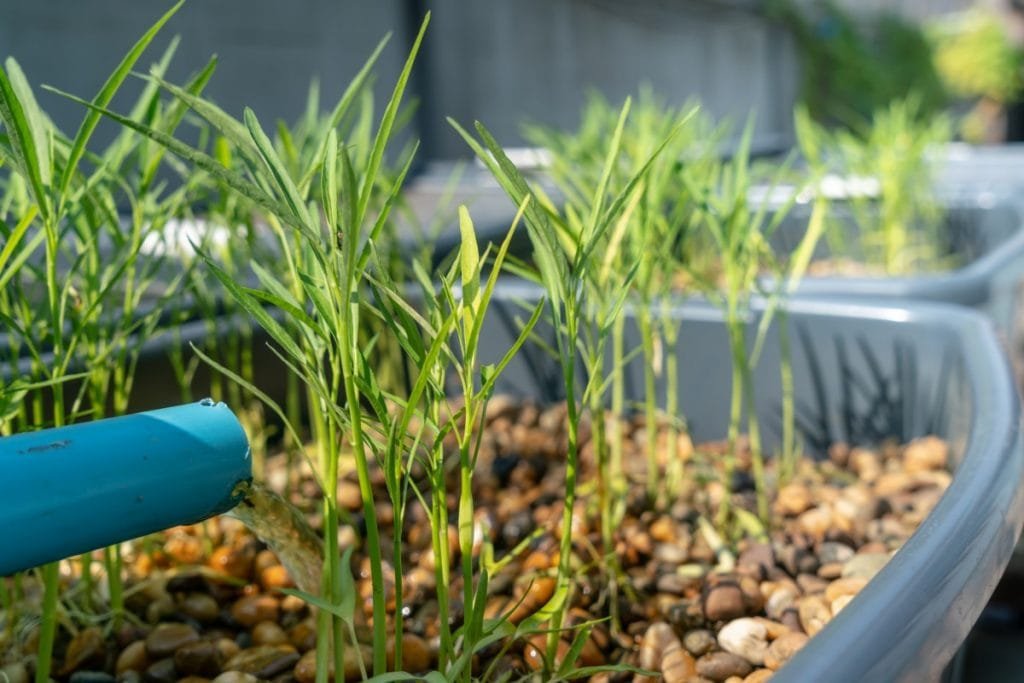
Bacteria in Aquaponics Systems
Bacteria are essential for converting the ammonia in fish waste into nitrate for plant growth. There are two main strands of naturally-occurring bacteria, Nitrosomonas and Nitrobacter. These are the two that have been most easily identified but there are many other bacteria that contribute to the nitrification processes.
Nitrosomonas convert ammonia into nitrite. Nitrite is still not useful to plants and is extremely toxic to fish.
Nitrobacter, the second strain, is required to convert the nitrite into nitrate, which can then be used by the plants. Extra nitrate is also harmless to fish.
These bacteria occur naturally but can take time for the colonies to become established. They have 5 main requirements:
- High surface area – porous materials and large plant areas provide homes for the bacteria to live
- Neutral to slightly basic pH – the bacteria require a pH between 6-8.5
- Warm water temperature – the water temperature needs to be between 63-93 deg F (17-34 deg C)
- Oxygen – adding an air stone to the system is an easy way to ensure there is enough
- Lack of UV light – bacteria cultures reproduce better without direct sunlight.
By converting ammonia into nitrite and nitrate, the water in the system becomes more acidic over time. Base solutions such as potassium hydroxide or calcium hydroxide can be added to stabilize the pH (a measure of acidity) to a neutral level.
Once stabilized, it is typical for an aquaponics system to have an ammonia concentration of 0.25-0.50 ppm, a nitrite concentration of less than 0.25 ppm, a nitrate concentration of 5-150 ppm, and a pH of 6.8-7.2. You can test these concentrations and pH using a kit such as the API Freshwater Master Test Kit.
Physical Components of an Aquaponics System
Several structures are needed to house the fish, plants, and bacteria. I’ll discuss these next, and later we’ll talk about how you can build your own aquaponics system at home.
The Hydroponics Subsystem: Grow Bed and Grow Medium
A large, flat, open container called a grow bed is used for the plants in the hydroponics subsystem. The grow bed is filled with a grow medium, a material that holds the bacteria and the plants. The considerations to keep in mind while selecting a grow medium are its price, surface area, and maintainability.
High surface area is needed for grow media because the nitrogen-converting bacteria in the system will completely cover all the surfaces in the grow bed. Low surface area materials can cause problems if there is not enough room for bacteria to provide the plants with adequate nitrate.
Common grow media with high surface areas are clay, expanded shale, and lava rock.
Rocks can also be used if they do not contain much carbonate. You can test for carbonate by putting rocks in white vinegar – if small bubbles begin to rise from the rocks, they contain carbonate and should not be used. Over time, carbonate will raise the pH of your system and could kill the bacteria.
The Aquaculture Subsystem: Fish Tank and Air Supply
To provide a healthy environment for the fish, you’ll want to keep them in a large tank filled with water. The tank is typically made of plastic. Be sure that any plastic tank you use is made of food grade plastic. You can read more about what plastics are safe for food and hydroponics in my articles, Is It Safe To Plant Vegetables In Plastic Containers? and Is PVC Safe For Hydroponics?
You’ll also want to include an air supply line in the tank. Normally an air stone with an air pump are used to add oxygen to the water. This helps circulate the water in case of any unexpected pump failures which could kill your fish. You will still need to protect against power outages, with a UPS, uninterrupted power supply. This is a common problem with aquaculture systems.
Mechanical Connections and Components
Water flows from the fish tank to the growth bed. Along the way, you should include a solid filtration stage, where you remove any solid particles from the water. Particles can interrupt the flow in the grow bed and will need to be removed for the system to run properly.
You’ll also need a pump. The pump is needed to pump water from the aquaculture tank to the grow bed. Depending on the size of your system, you’ll need a pump with a high flow rate, in the range of 2000-5000 liters per hour. Popular pumps can be purchased from Jebao, Sunsun, or Resun, among plenty of other suppliers.
An optional feature is a sump tank. Sump tanks hold the water between your grow bed and your fish tank, and can be used to control the water levels in both of them. Adding a sump tank can add versatility to your system, as we’ll see in different system designs.
Different Aquaponics System Designs
Several different aquaponics system designs have been used with great success. I’ll tell you about three of the most popular DIY designs that you can build at home. Large scale aquaponics facilities use these same designs, scaled up.
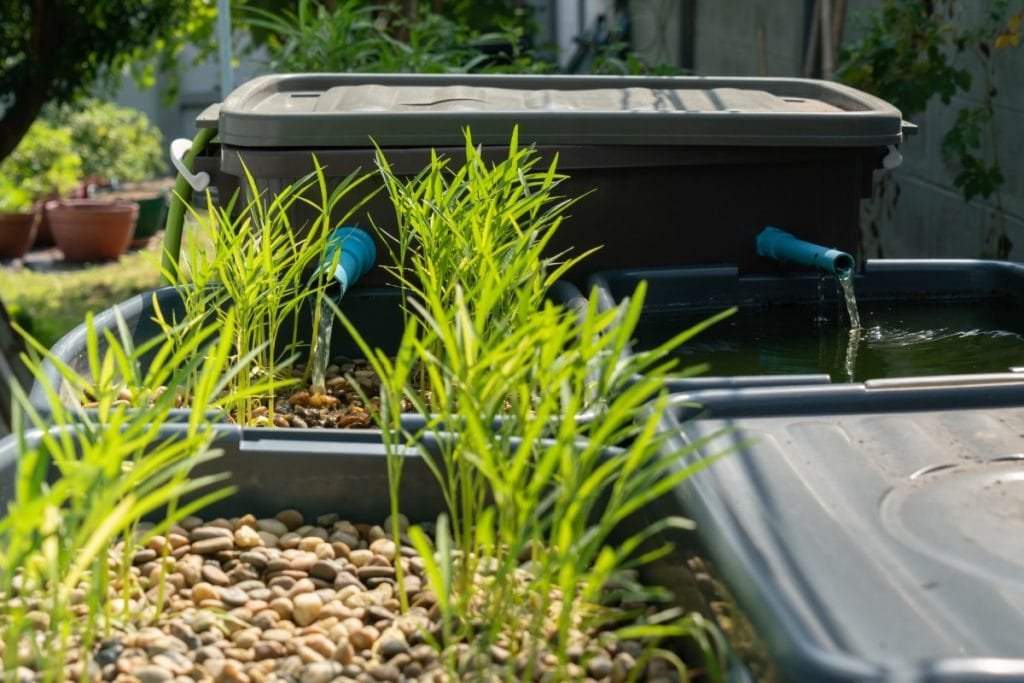
The Basic Aquaponics System Design
This simple design is great for starters if you’d like to try out aquaponics for the first time. All you’ll need is a fish tank with an air supply, a grow bed and medium, a pump, and some pipes.
The grow bed is filled with growing medium and is slightly angled so that water flows in one direction. The fish tank is filled with water and contains an air supply. The pump is installed at the bottom of the tank, with pipes leading to the top of the grow bed. At the lowest point in the grow bed, pipes lead back to the fish tank.
Water is pumped from the fish tank to the top of the grow bed. In the grow bed, the plants are fertilized and ammonia is removed from the water. Then, water flows back into the fish tank.
This design does not include solids filtration or a sump tank, but these are not as necessary on a small scale. If you’d like to install a solid filtration stage, you should include it at the outlet of the pipe at the top of the grow bed.
An Example of the Basic Aquaponics System Design: The Chop and Flip
One of the most popular manifestations of the basic design is called the Chop and Flip. It uses a large water container or barrel with a fraction of the top chopped off, around ¼ of the way down.
The top piece is flipped – this is the grow bed. The remaining ¾ of the container is the fish tank.
Connect the two with the appropriate pipes and pumps from above, add grow medium to the grow bed, and you’ve got yourself a basic aquaponics system!
The Single-Loop Aquaponics System Design
The single-loop design is more work than the basic design, but it will be more effective for larger aquaponics systems. It adds a sump and solid filtration stage to supply cleaner water in the grow bed, avoiding solid buildup. The sump also ensures that the fish will still have enough water even if the pump fails or other unexpected events occur.
The solid filtration stage goes after the fish tank and before the grow bed. This removes solid particles such as fish feces, shed skin, or uneaten food that can clog and block water flow in the grow bed.
The sump tank goes after the grow bed and before the fish tank. The grow bed drains clean water into the sump tank, which holds water to keep the water level constant in the fish tank.
The single-loop system is named because it has just one loop of water circulation. One benefit of this design is it requires a smaller, lower flow rate pump since the pump only sends water from the sump tank to the fish tank. Adding other loops adds a dimension of complexity, as we will see in our next design.
The Dual-Loop/Split Flow Aquaponics System Design
The dual-loop design is the most complex and most versatile. It has the same components as the single-loop design plus an additional biofilter component. The biofilter houses the ammonia-converting bacteria outside of the grow bed, held by simple high surface area materials such as cloths or even bottle caps.
In the dual-loop design, filtered, nitrate-rich water is stored in the sump tank. Water is pumped from the sump to both the fish tank and the grow beds, thus making it a dual-loop system. This can be done with a T- or Y-fitting pipe connector, or by adding an additional pump.
Water that is pumped into the fish tank picks up ammonia. The water is passed through a solid filter stage and then the biofilter. This removes any particulate from the water and converts the ammonia to nitrate. From the biofilter, the water is passed back into the sump tank, cleaned and nitrate-rich. This water is safe for the fish.
The other loop on the system goes from the sump to the grow bed. Since the water in the sump tank already is nitrate-rich and filtered, it can be used directly for growing the plants. Once passed through the grow bed, the water circulates back to the sump tank.
This design is particularly advantageous because it is adaptable. It is easy to turn off the water in one of the loops to perform routine maintenance without disturbing the whole system.
Operating Your Aquaponic System
Once you’ve built or bought an aquaponic system, the most difficult challenge that remains is getting it started. This process is called “cycling”, where you start up the nitrogen cycle in your grow bed to remove ammonia.
Before you plant all of your seeds and add your fish, you can add an ammonia source to the water and cycle it through the system. This will begin to grow the nitrate-producing bacteria in your grow bed. It will take between 3-6 weeks for them to fully colonize the grow bed.
The water should be checked daily for ammonia, nitrite, and nitrate concentrations using a test kit. For the bacteria to survive, ammonia concentration should be held between 0.5 and 4 ppm. You will likely have to add a little bit of ammonia every day to feed the bacteria.
Over time, nitrite concentration will increase, peak, and then decrease to 0 while nitrate concentration slowly increases. Once your nitrite concentration has been 0 ppm and your nitrate and ammonia concentrations have been approximately constant for a few days, your aquaponics system is ready. At this point, you can add fish and plants.
Once you’re operating normally, you should monitor the water levels in your system. You should top off the water in your system around once a week.
Benefits of Growing With Aquaponics
There are many unique benefits to growing with aquaponics:
- Your system is entirely organic. You cannot use harmful fertilizers or pesticides on your plants because these would kill the fish.
- It is efficient and clean. Environmentally harmful waste produced by the fish is directly recycled to help the plants grow.
- It is energy efficient. Operating the system only requires the usage of a single pump.
- It is water efficient. The plants you grow require 50 times less water than traditionally raised crops.
- It is profitable. The fact that you are growing both plants and fish means that you can operate profitably, even if either produce or fish prices go through a low period.
- It produces high yields with small land usage. Aquaponics produces significantly more produce and fish per acre than traditional agriculture or aquaculture.
- Consistent and high-quality yields. Your plants are not as susceptible to weeds, pests, and diseases. These usually make their home in soil, but aquaponics systems don’t use any soil. Harvests tend to be consistent and of high-quality.
Final Thoughts
Aquaponics systems can be used to profitably grow plants and fish with high efficiency, low land usage, and environmental sustainability. Because of its many advantages, large-scale aquaponics farms have been started in a few places around the world. People are trying it out for themselves in simple backyard aquaponics systems like the ones I described.
